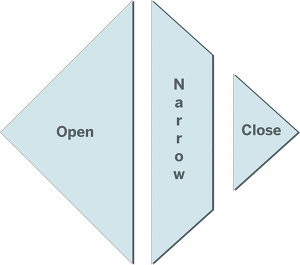Brainstorming’s highest value is not in producing the greatest number of ideas, but in (1) generating creative and innovate ideas, and (2) creating ownership for implementing those ideas.
Marc Andreessen’s “Quote of the Week” last week was “Why brainstorming is a bad idea.” Andreessen quoted Frans Johansson’s book, The Medici Effect:
“…In 1958…psychologists let groups of four people brainstorm about the practical benefits or difficulties that would arise if everyone had an extra thumb on each hand after next year. These people were called “real groups” since they actually brainstormed together. Next, the researchers let “virtual groups” of four people generate ideas around the “thumb problem”, but they had to brainstorm individually, in separate rooms. The researchers combined the answers they received from each [virtual group] individual and eliminated redundancies… They then compared the performance between real groups and virtual groups…
To their surprise, the researchers found that virtual groups, where people brainstormed individually, generated nearly twice as many ideas as the real groups.
…In a [1987 study, researchers] concluded that brainstorming groups have never outperformed virtual groups. Of the 25 reported experiments by psychologists all over the world, real groups have never once been shown to be more productive than virtual groups. In fact, real groups that engage in brainstorming consistently generate about half the number of ideas they would have produced if the group’s individuals had [worked] alone.
In addition, in the studies where the quality of ideas was measured, researchers found that the total number of good ideas was much higher in virtual groups than in real groups.”
Pretty solid hit to brainstorming, right? But before you throw brainstorming out the window and put up privacy doors on your company’s cubicles, let’s step back a bit. Brainstorming is just one tool for generating ideas, and often, not the best one for the job. As the saying goes, “A fool with a tool is still a fool.”
Certainly there is no “magic” to brainstorming. It will not, et voila, produce the longest list or highest quality list relative to other idea generation techniques. It is simply one process (actually, a sub-process: more on that in a minute) you might choose to reach a desired result. At the same time, it is a perfectly good tool for certain outcomes, as we’ll show. The key to success is to select your tool with the end in mind.
When is brainstorming appropriate? Evolutionary biologist and Binghamton University researcher David Sloan Wilson examined that question in the 2004 paper Cognitive cooperation: when the going gets tough, think as a group. His research demonstrated that, while individuals do just fine generating ideas when the content is simple, brainstorming outperforms individual idea generation when the content is complex. According to Wilson:
“Cooperation is most beneficial for tasks that exceed the capacity of individuals. This statement might seem so obvious that it doesn’t need to be made. However, the “unsettled state” of the literature that we described in the introduction requires a back-to-basics approach to cognitive cooperation in humans. We tested the most basic prediction for the game of Twenty Questions and found exactly what one might expect: Not only did groups outperform individuals overall, but their relative advantage increased with task difficulty.
… some research programs do ask the right questions from an evolutionary perspective and impressively show the advantages of thinking in groups, especially for difficult tasks. Two outstanding examples are the work of Edwin Hutchins (1995) on cognition in naturalistic situations and Daniel Wegner on what he calls “transactive memory” (1986; Wegner et al. 1991).”
Wilson likens the difference in process choice between brainstorming and individual idea generation to the difference between lifting a piano and screwing in a light bulb – you need a group to do one, but not the other. His research opened up the possibility that earlier studies on brainstorming neglected to consider a variety of variables that may have influenced their outcomes.
The lesson here is to match the process to the task. Stasson and Bradshaw’s research (1995) demonstrated this fairly obvious fact: if an individual does not have all of the information required for a good decision, then a group of people who can share information will be more effective. When you assemble a group to tackle complex problems in business, ensure the right people are in the room. Your outcome is not just a large quantity of ideas, but synergy. That is, leverage the ability of diverse group members to build on and enhance others’ ideas.
Now, let’s look at a passage from The Medici Effect that appears a few lines after the quote Andreessen cites:
“So, should we all stop brainstorming? I don’t think so. Done right, brainstorming is a highly effective way to actively generate intersectional ideas.” (emphasis ours)
Johansson goes on to offer several process suggestions. He advises that people brainstorm individually before the meeting. This serves two purposes. It seeks to correct one of the identified barriers to brainstorming’s effectiveness – the tendency for group members to forget promising ideas while they wait for others to finish offering theirs. Johansson notes pre-work like this also “forces the facilitator to develop a well-formulated problem statement, which has been shown to make brainstorming more effective.” He advises the facilitator “keep everyone involved, and keep the pace and action high.” He also suggests experimenting with a technique called brainwriting, a synergistic way of building on individual ideas that Johansson recommends to “ignite sparks of new ideas.”
It is perfectly reasonable to expect that four people in separate rooms will generate – collectively – a longer list of ideas than a group working together. Given an explicit and manageable task, capable individuals have a strong achievement motive and plenty of focus. Take those same individuals and put them into the group. In the group, several motives and need-fulfillment strategies are operating simultaneously, for example: needs for affiliation, control, and influence. It’s likely, therefore, that some of the generative power is directed to other mental and emotional activities.
We mentioned earlier that brainstorming is a sub-process. The output of brainstorming is ideas. But rarely do we generate ideas without intending to do something with them. At Interaction Associates, we teach people a group process called Open-Narrow-Close. Group brainstorming falls into the “Open” phase.
 Open-Narrow-Close Model, ©Interaction Associates
Open-Narrow-Close Model, ©Interaction Associates
This is a three-step process for generating ideas, organizing and evaluating ideas, and agreeing on a shortened list of ideas for implementation. Prioritizing and building agreements is, of course, a critical practice in most organizations.
Let’s assume you actually want to implement the ideas you’ve generated. Most of us consider two major factors: Is it a good idea? Will the people responsible for implementation support the idea?
Brainstorming’s highest value is not in producing the greatest number of ideas, but in (1) generating creative and innovate ideas, and (2) creating ownership for implementing those ideas. Brainstorming catalyzes synergy and ownership: that’s the pay-off.
People who participate in group process involving a generative activity like brainstorming will have greater support for and ownership of the ideas. They’ll be inclined to lend more discretionary effort to seeing “their” ideas implemented, which reduces the risk of failure. When you need the best ideas and shared responsibility for implementation, then brainstorming, followed by the necessary “narrow “ and “close” stages, will lead to better results.
The CEO of one of our client companies convened a cross-functional, multi-level group to come up with a list a ways to achieve profitable growth. The group brainstormed, narrowed the list they had generated, and agreed on 42 ideas. They presented these suggestions to the CEO, who incorporated them to the company’s strategic plan. When we asked what he thought of group’s work, the CEO said he was delighted. “Even if they weren’t the very best ideas, the fact that my employees own them will pay off for me,” he explained.
Which is why we conclude that brainstorming isn’t such a bad idea, after all.
Originally published at interationassociates.com. Used by permission.







